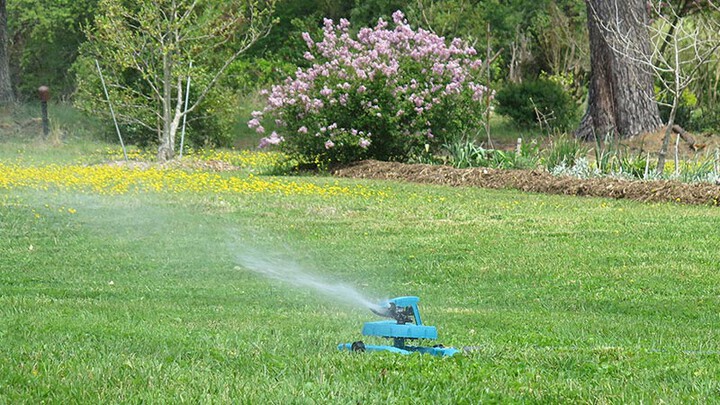When heat and drought set in, lawns may turn brown and appear lifeless. However, they may not be dead, but conserving resources until conditions improve. For both cool and warm climate lawns, seasonal dormancy is normal.
The best way to make sure your lawn bounces back from a period of dormancy is to continuously take care of it. A lawn that is well-watered, free of weeds, and mowed properly will experience less dormancy with faster recovery times.
How to Revive Brown Grass

·Water
Naturally, rain will revive a brown lawn. However, if rainfall is insufficient watering the lawn deeply once a week will help your lawn to spring back to green. With Gilmour’s Pattern Master Circular sprinkler, you can customize the spray area so you water only the lawn and not the sidewalk. Set up a timer on your spigot, so the sprinkler will come on for 15-20 minutes per watering session. The best time to water is early in the morning between 6 a.m. and 10 a.m., when it’s usually less windy and when temperatures are low.
· Mow
Once grass starts to grow again, it’s okay to mow with your mower set to 3 ½ inches. Do not scalp the lawn to try to remove brown blades of grass. Let new fresh grass grow around them. Leave grass clippings on the lawn to fertilize the lawn naturally.

- Weed
When soil is rehydrated and grass plants turn green, so will the weeds. Remove them by hand or spot-treat with a natural herbicide by following directions on the label.
Dormant Lawn FAQs
How can I tell if my grass is dormant (brown) or dead?
One way to determine if grass is dormant or dead is by tugging on the grass plants. If the plants pull out from the ground easily, they’re probably dead. If the roots hold fast when pulled, the plants are dormant. You will also see the difference when you start to water or when rain returns as moisture will revive brown grass. However, it will not bring dead grass plants back to life.
Why is my grass turning brown?
Grass turns brown in response to stress. Heat and drought put a lot of stress on grass during the summer. Even warm climate grasses may turn brown for a few weeks.
How long can a lawn go without water?
A healthy lawn can survive up to four weeks without water. If a drought persists, water with a Gilmour Flexogen Super Duty hose and Adjustable Wind-resistant Rectangular Sprinkler by following these tips.

What can I do to help my lawn before dormant periods?
Lawns should be watered deeply but infrequently, about once a week, for 20-30 minutes. Watering before summer dormancy will encourage grass plants to develop deep roots, giving them better access to moisture in the soil.
How can I protect my lawn when the grass turns brown?
You can take care of a brown lawn by limiting further stress on grass plants. Mow less often, or not at all, during a drought. If you do mow, set the mower height higher than normal at about 3 ½ inches. Tall blades of grass shade the soil, which reduces evaporation and retains moisture. When grass is dormant or beginning to grow again, it’s best not to walk on it.
What about fertilizing?
Do not fertilize a brown lawn. You do not want to promote leaf growth at a time when the roots have little access to moisture.
What about weeds? Are they dormant, too?
Some weeds may grow while the grass is dormant. Dandelions, for example, are perennial weeds with tap roots that reach into the soil for moisture. They can survive heat and drought. The best way to keep weeds in check is to maintain a healthy lawn. If you see weeds actively growing when your lawn is dormant, pull them by hand or spot-treat with an organic herbicide (follow directions on the label).
If hot weather and drought make your grass turn brown, just remember that brown lawns are not necessarily dead lawns. Good lawn care practices and a little patience are all you need.